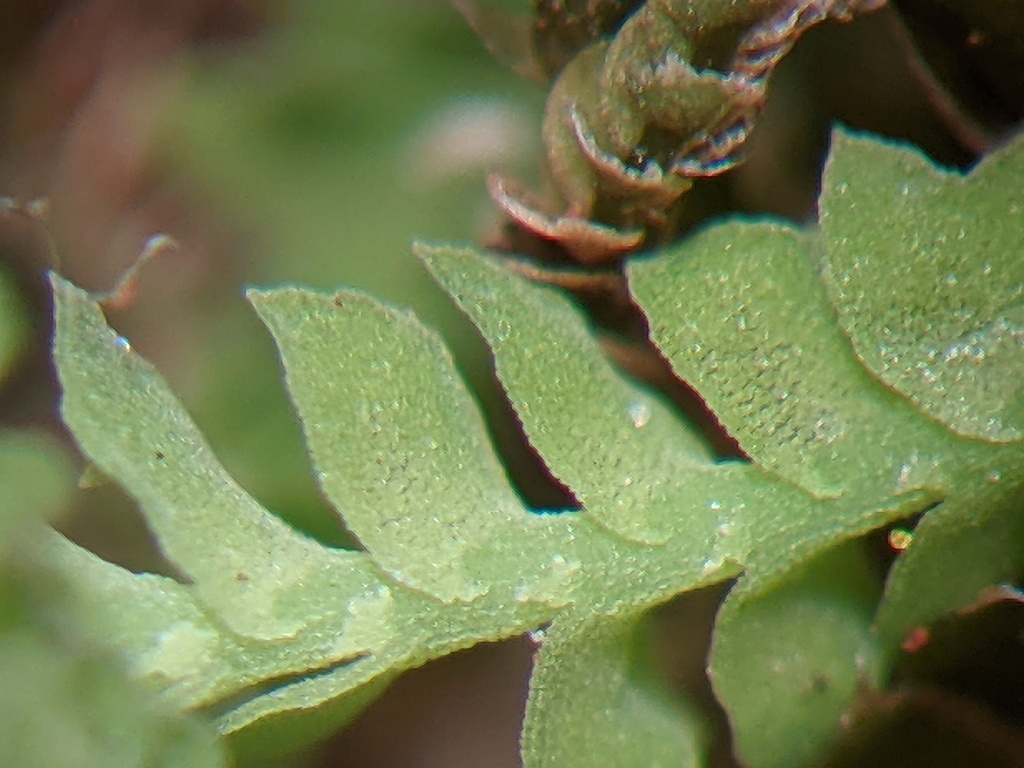Acrobolbus
Epiphytic, lithophytic or terrestrial, dioicous. Asexual reproduction by caducous (not in Victoria) or fragmenting leaves (not in Victoria). Stems with two ranks of lateral leaves and occasionally with minute underleaves, creeping and sparingly branched, with all branches similar or with normal leafy and microphyllous stems, or frequently branched and differentiated into creeping microphyllous stems with rhizoids and erect stems with normal leaves and without rhizoids, smooth or conspicuously papillose; branches emerging from main stem from near lateral leaves or from ventral side of stem and with a collar of tissue at base or rarely emerging from near abaxial side of lateral leaf and without a collar of tissue at base. Leaves reniform (not in Victoria) or oblong to ovate, orbicular or obovate in outline, unlobed, bifid, or rarely with 3–4 lobes (not in Victoria), with entire to dentate margins, alternate, spreading parallel to the substrate or usually perpendicular to substrate when stems erect, remote to imbricate, concave to convex adaxially, green, yellow green or lime green; lobes equal or not, rounded or acute. Underleaves when present subulate to lanceolate-triangular, much narrower than stem or vestigial and composed of up to 5 cells. Leaf cells polygonal, papillose, rarely smooth, with or without distinct trigones, with 1–50 oil bodies; oil bodies brown, ovoid, ellipsoid or fusiform, granular-botryoidal. Rhizoids sparse in abaxial tufts or scattered abaxially on stems, occasionally marginal on leaves, hyaline. Androecia on main stem or on branches with or without normal leaves, with 4–30 saccate bracts, each with 1–14 antheridia. Sporophyte terminal on normal leafy stems or branches, or terminal on branches with hyaline bracts that emerge from near stem bases, surrounded by a pendent marsupium, without a perianth, with or without bracteoles; marsupium ovoid to ellipsoid, not subterranean, covered with rhizoids or glabrous. Capsule ellipsoid, cylindric or ovoid, 4–6-stratose, rostrate.
Thirty-seven species mostly in southern South America, New Zealand and south-east Australia, but also Pantropical and in South Africa, Macaronesia, the Azores, Ireland and the UK, North America, Japan and China (Söderström et al. 2016; Schuster 2021); six species in Victoria.
Marsupidium and Tylimanthus has previously been recognised as distinct from Acrobolbus, with both genera having axes clearly differentiated into microphyllous creeping rhizoid-like stems and erect normal leafy stems and have antheridial bracts with several androecia. Marsupidium and Tylimanthus were distinguished based on the position of the sporophyte, typically terminal on normal leafy stems in Tylimanthus and on branches with hyaline bracts emerging from near the base of leafy stems in Marsupidium. However, these distinctions are obscured by species that exhibit intermediate states between these proposed genera, e.g. A. cinerascens (Lehm. & Lindenb.) Bastow with microphyllous stems and androecial bracts with one androecium and some Marsupidium such as M. flavicans J.J.Engel & Grolle, have terminal sporophytes on normal leafy shoots as well as on basal branches without normal leaves. These poorly defined genera also do not form separate lineages in phylogenies based on chloroplast DNA sequences, but instead a broader Acrobolbus, including Marsupidium and Tylimanthus is composed of lineages that reflect geography rather than previous taxonomic divisions (Briscoe et al. 2017). Consequently, Marsupidium and Tylimanthus are now included within Acrobolbus.
Briscoe, L.R.E., Zerega, N.J.C., Lumbsch, H.T., Stech, M., Kraichak, E., von Konrat, M.J., Engel, J.J. & Wickett, N.J. (2017). Molecular, morphological, and biogeographic perspectives on the classification of Acrobolboideae (Acrobolbaceae, Marchantiophyta). Phytotaxa 319: 56–70.
Schuster, R.M. (2021). Austral Hepaticae Part III. Nova Hedwigia Beiheft 120. Cramer in der Gebrüder Borntraeger Verlagsbuchbehandlung: Stuttgart.
Söderström, L., Hagborg, A., von Konrat, M., Bartholomew-Began, S., Bell, D., Briscoe, L., Brown, E., Cargill, D.C., Costa, D.P., Crandall-Stotler, B.J., Cooper, E.D., Dauphin, G., Engel, J.J., Feldberg, K., Glenny, D., Gradstein, S.R., He, X., Heinrichs, J., Hentschel, J., Ilkiu-Borges, A.L., Katagiri, T., Konstantinova, N.A., Larraín, J., Long, D.G., Nebel, M., Pócs, T., Puche, F., Reiner-Drehwald, E., Renner, M.A.M., Sass-Gyarmati, A., Schäfer-Verwimp, A., Moragues, J.S., Stotler, R.E., Sukkharak, P., Thiers, B.M., Uribe, J., Váňa, J., Villarreal, J.C., Wigginton, M., Zhang, L. & Zhu, R. (2016). World checklist of hornworts and liverworts. Phytokeys 59: 1–828.
 Spinning
Spinning